|
The
Sun Yat-sen suit
Sun Yat-sen (Sun Zhongshan) (1866-1925), the
Provisional President of the new Chinese Republic proclaimed
in 1911, is credited with the modernisation of Chinese
men's dress. It is said that he instructed Huang Longsheng,
a Western-style tailor from Zhejiang Province, to design
a suit based on one commonly worn by Chinese men in
Japan and south-east Asia. The early form of Sun Yat-sen
suit (Qilingwenzhuang) had a closed stand collar
and centre-front buttons. The design of the Sun Yat-sen
suit changed significantly over the course of some 50
years.
A
major and lasting change to the design of the Sun Yat-sen
suit (Zhongshan fu) was the incorporation of
elements of German military dress including a turndown
collar and four symmetrically placed pockets. Over time
small stylistic changes were made to the design. It
is the later style of Sun Yat-sen suit which was further
modified and adopted as China's national dress by Mao
Zedong after 1949.
|
Nationalism
in dress
Long after Sun Yat-sen's death, popular mythology
assigned a revolutionary and patriotic significance
to the Sun Yat-sen suit, even though it was essentially
a foreign-style garment. The four pockets were
said to represent the Four Cardinal Principles
cited in the classic Book of changes and
understood by the Chinese as fundamental principles
of conduct:
- propriety
- justice
- honesty
- a
sense of shame.
The
five centre-front buttons were said to represent
the five powers of the constitution of the Republic
and the three cuff-buttons to symbolise the Three
Principles of the People
- nationalism
- democracy
- people's
livelihood.
|
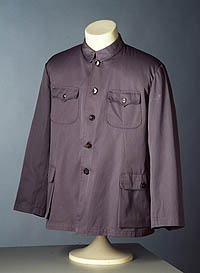
Grey, modified Sun Yat-sen
suit: The sleeves of the jacket, designed
to cover the knuckle of the thumb, were longer
than a Western suit. The loose fit allowed
for ease of movement. Made in the 1970s. Powerhouse
Museum collection. 98/126/85
|
|
|
Soviet
influence on Chinese dress
During the first decade of the People's Republic
of China (1949-59) the Soviet Union exerted a
strong influence on Chinese economics, industry,
art education and culture. Russian experts were
invited into universities and colleges to teach
students. Soviet artists also taught at the influential
Central Academy of Fine Art in Peking, training
artists in Socialist realist painting techniques.
Russian
language, Marxism and Leninism were compulsory
subjects and Russian language skills enhanced
one's social standing. Dress too, came under Soviet
influence. Those women who wore the fashionable
Lenin suit, a jacket and trouser ensemble
made from cotton or sometimes wool, were displaying
their political allegiance.
Young
Pioneers were regarded as the hope of the future.
The triangular red scarf was said to represent
a corner of the Communist flag, dyed red from
the blood of martyrs. This outfit was worn to
a rally for Mao Zedong in Tiananmen Square on
1 October 1961, China's National Day.
|
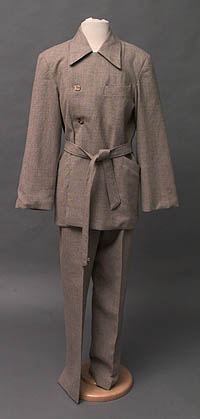
Beige Lenin suit (Liening
fu): Woollen Lenin suits were worn by
women at the Communist revolutionary base
in Yenan in the early 1940s. They continued
to be worn during the 1950s. Powerhouse Museum
collection. 98/126/1
|
|

Young Pioneer outfit: This
child's outfit is known as Zhuo Ya fu. Zhuo
Ya was the name of a Russian World War II child-hero.
The white shirt is made of synthetic fabric which
did not require precious cotton ration coupons.
Powerhouse Museum collection. 98/126/66
|
The
Mao suit: ideology expressed through dress
Mao Zedong recognised the power of dress to project
nationalism and ideology. On 1 October 1949 at the grand
ceremony in Beijing marking the founding of the People's
Republic of China, he wore a modified form of the Sun
Yat-sen suit. Mao had worn this style of suit since
1927 but it was only after 1949 that it was adopted
by the majority of the Chinese population. It is known
in the West as the Mao suit.
|
During
the 1950s to 1970s most older men wore the modified
Sun Yat-sen suit, while the young preferred a
military-style suit known as zhifu. It
differed from the Sun Yat-sen suit in that the
upper and lower pockets were concealed with a
flap and had no external button. To Western eyes
both the uniform and the Sun Yat-sen suit appeared
similar. Also known as military plain clothes,
this all-purpose, loose-fitting outfit worn by
the majority of the population became the sartorial
symbol of Communist China.
The
zhifu was worn by both men and women, of
all ages and classes. The dominant colours were
navy blue and grey. In addition to the zhifu,
men and women also wore a limited range of clothing
styles - mostly trouser suits differentiated by
the styling of the collar and pockets.
|

Navy blue military-style
uniform (zhifu): the zhifu could
be blue, black, grey or khaki. The majority
of the population usually wore blue and the
military wore khaki. Made in the 1970s.
Powerhouse Museum collection. 98/126/86
|
|

Family group at Beihai Park, Peking,
in the early 1950s. The father wears a modified
Sun Yat-sen suit. Powerhouse Museum collection.
|
|
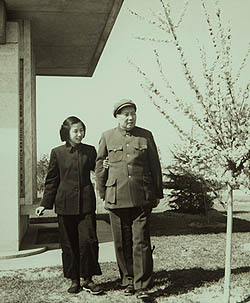
Photograph by Hou Bo of Mao Zedong
with his daughter Li Na taken in Peking in 1953.
Mao Zedong is wearing a modified Sun Yat-sen suit
with turn-down military-style collar, four patch
pockets and five centre-front buttons. By modifying
the Sun Yat-sen suit, Mao was seen to be inheriting
and developing aspects of the revolutionary legacy
of Sun Yat-sen. Powerhouse Museum collection.
|
The
Great Leap Forward
After the establishment of the People's Republic of
China in 1949, Western-style suits were a symbol of
the old society. Fabric was expensive but labour
was cheap, so many people had clothes refashioned. And
in the late 1950s after the disastrous Great Leap Forward,
which was to have increased productivity, rationing
was introduced for most materials and commodities, which
made recycling clothing imperative.
In
the 1960s people were so poor they could not afford
all new clothes, giving rise to the invention of the
pretty face, a false shirt front attached to
a jacket.
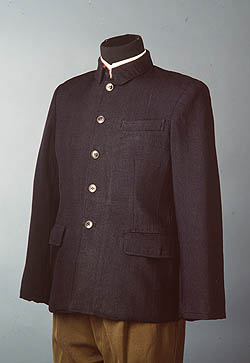
Revolutionary uniform: Man's uniform
jacket (zhifu) re-fashioned in the 1950s
from a navy-blue Western-style woollen suit. Powerhouse
Museum collection. Photo by Sue Stafford. 98/126/97
|
|
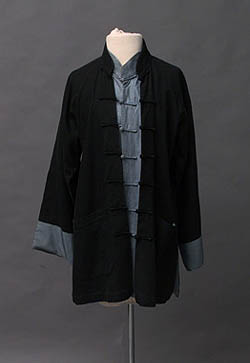
Man's Chinese-style pretty face
jacket (qianlian mei) made of raw silk with
a false pale blue shirt-front attached, hence the
name pretty face. It was made in 1964 for a 25-year-old
member of a village production brigade in Hebei
Province to wear to village market fairs. Powerhouse
Museum collection. Photo by Sue Stafford. 98/126/4
|
Military
dress in the People's Republic of China
A person's rank can be discerned by observing details
of their uniform. At the most fundamental level rank
was reflected in the number of pockets on the jacket.
From 1966 onwards a soldier's uniform had two upper
pockets whereas an officer's uniform had two upper and
two lower pockets.
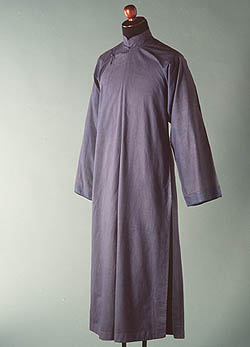
Robe from the old society:
This long robe (changpao) was worn by a 17-year-old
peasant boy on the day he left his village to join
the People's Liberation Army. The robe, made by
a tailor, was a parting gift from the boy's proud
mother who had saved money from selling chicken
eggs to pay for it. However, it was quickly replaced
by an army uniform as it was inappropriate for a
new recruit to dress as an educated gentleman. The
owner kept the robe for 50 years, in memory of his
mother's pride.
* Cotton, made in Huolu County, Hebei Province,
1948. Powerhouse Museum collection. Photo by Scott
Donkin. 98/126/23 |
|
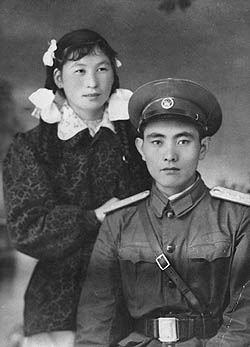
People's Liberation Army soldier
and woman, late 1950s. Powerhouse
Museum collection. |
Garments
for women
Women's clothing from the 1950s to the 1970s was functional
and limited in style. Most women dressed in sympathy
with the proletariat and wore loose-fitting trouser
suits, lacking in ornamentation. The most common colours
were dark blue, grey or khaki. There was a range of
jacket and shirt styles, primarily distinguished by
the detailing of the collar and pocket.
|
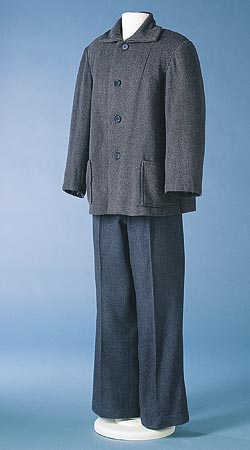
Patriotic wool suit:
Patriotic wool, also known as rag wool, is so-called
because it is woven from leftover threads swept
from workshop floors combined with a small amount
of good wool.
This
suit was made for a 30-year-old technician working
in a textile factory in 1961, a time of severe
economic hardship. Despite its poor quality, the
fabric was popular because ration coupons were
not required to purchase it. The jacket and trousers
were made at different times hence the different
colours of the fabric. Powerhouse Museum collection.
98/126/12.
|
|